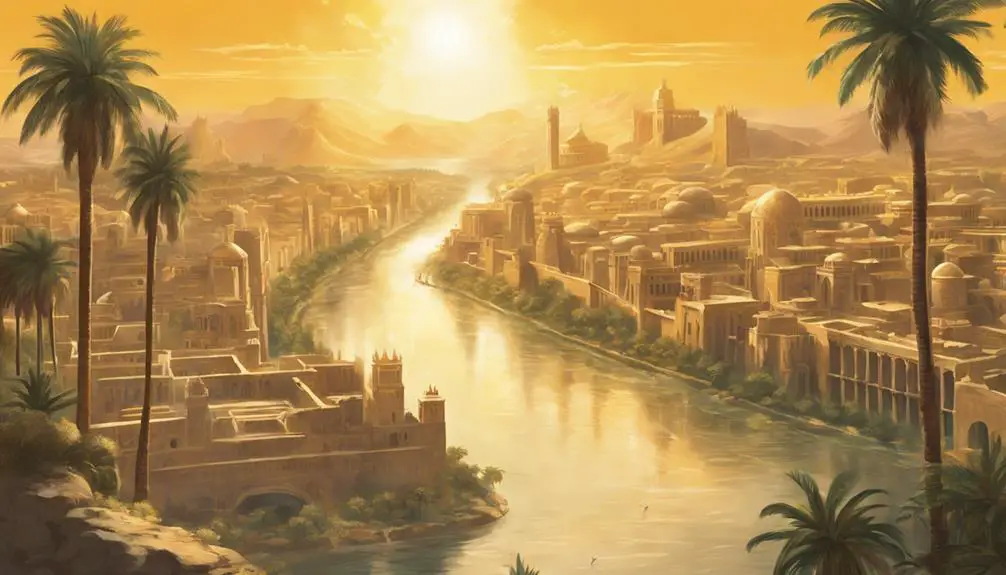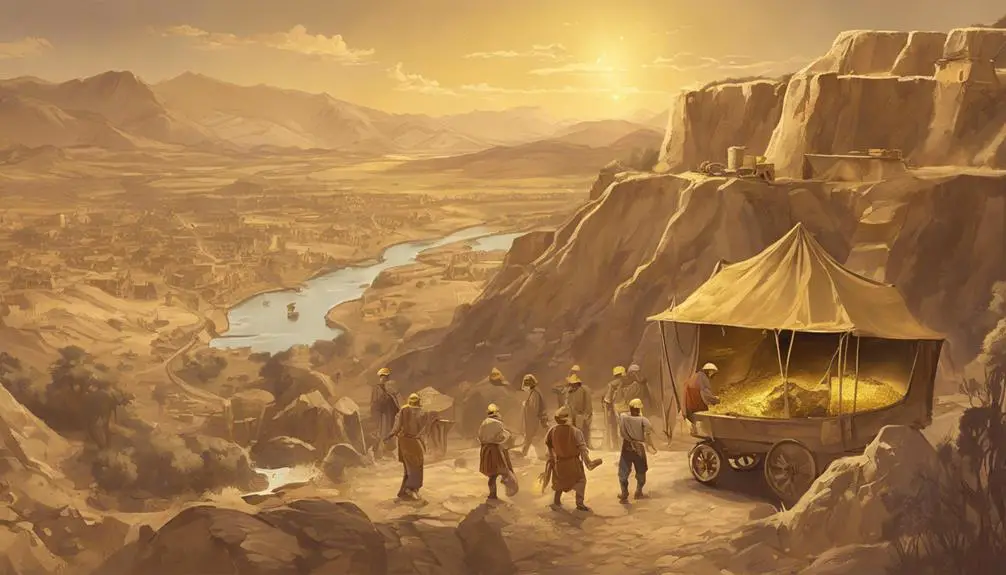Investigate the enigmatic Uphaz in the Bible, known for its exquisite gold, and uncover a story veiled in mystery and rich significance.
Uphaz in the Bible
As they say, all that glitters is not gold, but when it comes to Uphaz in the Bible, you're in for a story where the luster may just hold a deeper significance.
You've likely skimmed past the mentions of this mysterious location, known for its fine gold, without giving it much thought. However, the scarcity of direct references and the debate over its exact geographical location or symbolic meaning add layers of intrigue.
By exploring what scholars suggest about Uphaz's gold and its cultural significance, you'll uncover perspectives that might shift your understanding of biblical narratives and their connection to historical realities.
Why this matters in today's context, however, is a question that invites you to look closer.
Key Takeaways
- Uphaz is a biblical location famous for its exceptionally pure and valuable gold.
- The exact geographical location of Uphaz remains uncertain, sparking scholarly debates.
- Gold from Uphaz symbolizes purity, divinity, and was used in religious artifacts and ornamentation.
- The cultural and religious significance of Uphaz gold underscores its role in ancient societal hierarchies and beliefs.
Biblical References to Uphaz

The term 'Uphaz' appears in the Bible in contexts that suggest a geographical location renowned for its fine gold, offering us insights into the ancient world's trade networks and value systems. This reference, however, comes with a layer of geographical uncertainty, making it a topic of intrigue and scholarly debate. You'll find that the ambiguity surrounding Uphaz's exact location doesn't diminish its importance in biblical narratives; instead, it amplifies the allure, hinting at the complexities of historical geography and the interpretative challenges scholars face.
Analyzing the mentions of Uphaz in scripture, you're drawn into a world where prophetic symbolism intertwines with tangible reality. These references aren't merely throwaway lines; they're woven into the fabric of the narratives, enriching the text with layers of meaning that go beyond the physical. The gold of Uphaz isn't just a symbol of wealth; it's a metaphor for purity, divinity, and the pursuit of spiritual excellence. This dual nature of Uphaz, as both a place and a symbol, showcases the Bible's depth, where geographical uncertainty serves not as a barrier but as a bridge to deeper understanding and reflection.
The Search for Uphaz
In your quest to demystify the enigmatic location of Uphaz, it's essential to sift through a myriad of historical and scriptural evidence, each piece potentially inching scholars closer to understanding its true significance in biblical geography. Geographic theories on Uphaz's whereabouts have flourished, ranging from identifications with known ancient gold-producing regions to speculative locales based purely on etymological analyses. These theories don't just emerge from a vacuum; they're often supported by archaeological evidence that hints at trade routes and gold craftsmanship that could have connections to the biblical references of Uphaz.
Archaeological evidence plays a crucial role in this scholarly detective work. Excavations in regions historically known for gold production have yielded artifacts and inscriptions that scholars attempt to link to Uphaz. Yet, the absence of a definitive inscription bearing the name 'Uphaz' means that any connection remains speculative. This doesn't deter the scholarly community, however; instead, it fuels a continued interdisciplinary approach, combining biblical scholarship with ancient economic history and archaeology, in the hope of uncovering concrete evidence that can anchor Uphaz firmly on the map of ancient world geography.
Uphaz's Gold Explained

Delving into the biblical references to Uphaz, one discovers that its gold, often compared to that of Ophir, holds a mysterious allure, suggesting a quality and purity unparalleled in the ancient world. This gold's esteem in ancient texts isn't merely by chance but is rooted in its remarkable characteristics and the complex trading routes that facilitated its distribution.
Characteristic |
Detail |
|---|---|
Purity |
Exceptionally high, with minimal impurities, making it sought after for both ornamentation and religious artifacts. |
Appearance |
Bright, with a distinctive sheen that set it apart from other gold sources. |
Rarity |
Its scarcity added to its value, making it a symbol of wealth and divine favor. |
Trading Routes |
Extensive, reaching across known ancient civilizations, indicating a sophisticated network of trade. |
Comparison to Ophir |
Often likened to, yet distinct from, the gold of Ophir, suggesting unique mining locations or refinement processes. |
The trading routes, in particular, highlight the strategic importance of Uphaz's location, serving as a nexus for commerce and the exchange of cultural ideas. Through these routes, the gold purity became a standard for trade, influencing economic systems far beyond its geographic origins.
Cultural Significance
Beyond its remarkable physical and economic attributes, Uphaz's gold also held profound cultural significance, reflecting deep spiritual beliefs and social hierarchies within ancient societies. This precious metal wasn't just a symbol of wealth; it was deeply intertwined with the cultural fabric, carrying significant religious implications and shaping historical contexts. Here's how:
- Symbol of Divine Connection: Gold from Uphaz was often associated with divinity and worship. It wasn't merely used for adornment but served as a tangible link between the divine and the earthly, manifesting the gods' presence in temples and rituals.
- Indicator of Social Status: Possession of Uphaz gold signified high social standing. It wasn't just a display of wealth but a marker of power and prestige, distinguishing the elites from the common masses in clear, visible terms.
- Medium of Cultural Expression: Through intricately crafted artifacts and religious paraphernalia, gold from Uphaz became a canvas for expressing cultural narratives. Artisans channeled their craftsmanship to narrate stories of gods, heroes, and the cosmos, embedding deep cultural and religious implications within their work.
In these ways, Uphaz's gold transcended its material value, embedding itself deeply within the cultural and religious tapestry of ancient societies.
Modern Interpretations

Contemporary scholars often reinterpret Uphaz's gold, examining its historical significance through modern lenses to uncover nuanced cultural and spiritual insights. You'll find that recent studies delve into linguistic analysis to unravel the origins and meanings embedded within ancient texts. This approach sheds light on how Uphaz's gold isn't just a symbol of wealth but represents divine purity and splendor in biblical narratives.
Through meticulous examination, experts have unearthed theological implications that resonate with today's spiritual discussions. You're invited to explore how interpretations of Uphaz intertwine with broader biblical themes, such as redemption and divine craftsmanship. This connection illuminates the text's relevance, providing you with a deeper understanding of its timeless messages.
Moreover, scholars argue that Uphaz's gold, when viewed through a contemporary perspective, challenges traditional interpretations. They suggest that its representation in scripture may have evolved, reflecting shifts in theological thought and cultural contexts. You're encouraged to consider these modern interpretations as a means to engage with the Bible in a more dynamic and relevant manner.
Frequently Asked Questions
How Does the Mention of Uphaz in the Bible Compare to References of Gold in Other Ancient Texts Outside of the Bible?
When you explore gold symbolism in ancient texts, you uncover a wealth of meaning far beyond its material value.
The mention of gold, including the mysteries of Uphaz, often symbolizes purity, divine principles, and immense wealth.
Comparatively, references in other texts mirror this, yet with unique cultural twists that illuminate different values or beliefs.
This analytical dive reveals how societies revered gold, embedding it with layers of spiritual and worldly significance.
Are There Any Traditional Songs, Hymns, or Prayers That Specifically Mention Uphaz, and What Is Their Historical Context?
Ironically, while you'd expect a treasure trove of melodies celebrating its splendor, Uphaz doesn't star in traditional songs, hymns, or prayers.
Diving into its musical origins and cultural significance, one finds a surprising silence. This absence invites a scholarly curiosity.
Why, with its biblical mention, isn't Uphaz immortalized in musical form? Analyzing this gap, we uncover layers of historical context and cultural choices shaping its exclusion from the canonical soundscape.
What Were the Economic Implications of Gold From Places Like Uphaz on the Ancient World's Trade Networks?
You're exploring how gold, especially from regions like Uphaz, impacted ancient trade networks. Gold valuation was crucial, acting as a standard for economic stability and wealth accumulation.
Trading routes were significantly influenced by the quest for gold, leading to the establishment of expansive networks. These routes not only facilitated the exchange of goods but also ideas and cultures, profoundly shaping the economic and social landscapes of ancient civilizations.
How Have Archaeological Findings Influenced Our Understanding of the Geographic Location and the Existence of Uphaz?
Interestingly, 80% of ancient gold artifacts' origins remain a mystery, sparking curiosity about places like Uphaz. Archaeological findings have reshaped our understanding of its geographic location and existence.
Diving into Uphaz's etymology and modern interpretations, scholars now analyze artifacts and texts to pinpoint its location more accurately. This analytical approach has provided a deeper insight into ancient trade networks, challenging previous notions and enriching our historical knowledge.
Has the Mention of Uphaz in Religious Texts Impacted the Naming of Modern Places or Institutions, and if So, in What Ways?
When exploring modern naming trends, you'll find that religious texts have significantly influenced the names of places and institutions. Specifically, the mention of Uphaz has sparked Uphaz-inspired art and even influenced some modern names, reflecting a deep cultural and historical reverence.
This phenomenon showcases how ancient words can shape contemporary identities, embedding historical narratives into the fabric of today's society, thereby linking past and present through linguistic and artistic homage.
Conclusion
In your journey through biblical texts, you've stumbled upon the elusive Uphaz, a name tied intimately with gold of exceptional purity. Coincidentally, this quest mirrors the broader search for spiritual richness and understanding.
Analyzing Uphaz not only unveils a historical curiosity but also reflects our continuous pursuit of value, both material and spiritual. As scholars dissect its cultural significance and modern interpretations, they're reminded of the timeless human endeavor to find meaning in the divine, a pursuit as golden as Uphaz itself.



Sign up